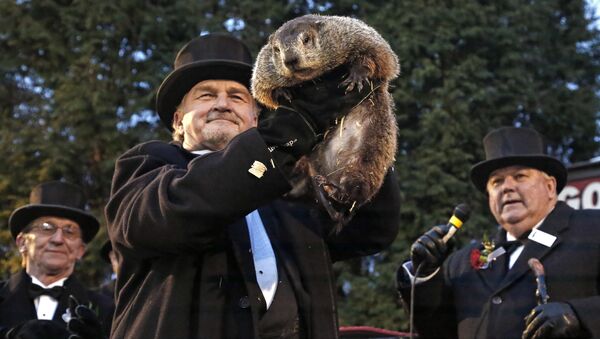According to superstition, if a groundhog comes out of its den on this day and sees its shadow, winter will last six more weeks. If the rodent does not see its shadow, it is then believed that spring will come early.
READ MORE: Rodent Predicts Persisting Winter as Groundhog Day Celebrated in US (VIDEO)
This tradition's roots date back to ancient history. The Romans celebrated February 2 as Hedgehog Day and similarly tried to predict the arrival of spring based on the hedgehog's behavior after it came out of hibernation. The people of Western Europe later continued to uphold this tradition. In northern Germany, for example, a badger became the weather-predicting animal. Thus, European settlers brought the tradition to the United States, where the job of the meteorologist was entrusted to the groundhog.
Groundhog Day remained a mere superstition until February 2, 1886, when a humorous article appeared in a local newspaper in the town of Punxsutawney in the US state of Pennsylvania.
"Today is Groundhog Day and up to the time of going to press the beast has not seen its shadow," the article said.
The article also named the location from where the weather would be predicted most accurately by the groundhog — Gobbler’s Knob on the outskirts of town. A crowd of locals gathered there on February 2 the following year, eager to know whether or not they would be getting an early spring. Then the newspaper’s editor, Clymer Freas, jokingly announced that a club of spirited groundhog hunters be established. They named themselves The Punxsutawney Groundhog Club, and, in early 1888, a house for the groundhog was built on Gobbler’s Knob.
It took a while to pick a name for the animal. Initially, it was just called the Groundhog from Punxsutawney, but was later renamed to Pete before finally becoming Phil. Its official name, however, is Punxsutawney Phil, Seer of Seers, Sage of Sages, Prognosticator of Prognosticators, and Weather Prophet Extraordinary, and the town of Punxsutawney is proudly called the "Weather Capital of the World."
READ MORE: Polar Vortex Brings ‘Frost Quakes', Eerie Weather Phenomena to US Midwest
An annual ceremony on February 2 wakes the animal from hibernation. The celebration begins at night with loud music and rumbling from fireworks. At exactly 7:25 a.m. (12:25 GMT) on Groundhog Day, members of the club, dressed in tuxedos and top hats, pull the groundhog out of its burrow so that it can make its forecast. Thousands of people watch the spectacle in person, on TV and online. Then, Phil is placed on a special stage so that everyone can see him. He then participates in a photo shoot and later is taken to a tour of the city center, where celebrations take place. Phil is taken back to his burrow only at the end of the day.
The Groundhog Day ceremony was canceled just once, in 1942, since such a show was considered inappropriate less than two months after the attack on Pearl Harbor.
Since 2010, the Groundhog Club has been hosting Breakfast with Phil in Punxsutawney, where guests are able not only to take pictures of the awakened groundhog, but also to offer him a nut. One of the club's services offers people the ability to receive Phil’s forecast by text message.
In recent years, a number of environmental organizations and humane societies have been expressing their outrage at the tradition of waking a sleeping animal, claiming that it was harmful to its body. They have also said that large crowds and TV cameras were stressing out the groundhog.
Phil is not the only weather-predicting groundhog in the United States. A groundhog named Staten Island Chuck lives in the Staten Island Zoo in New York City and is considered the city's official groundhog meteorologist. On February 2, the mayor of the city traditionally attends a ceremony at the zoo. There is also Dunkirk Dave in the city of Dunkirk, the westernmost city in the state of New York.
The furry meteorologists live in other US cities as well. T-boy the Nutria hails from New Orleans, Louisiana; Stormy Marmot from Colorado; Holtsville Hal from New York's Long Island; Woodstock Willie from Illinois; and Buckeye Chuck from Ohio, among many others.
READ MORE: Welcome to the Jungle: US Army Tests More Breathable Hot Weather Uniforms
They have numerous colleagues who live in neighboring Canada. The most famous one was Wiarton Willie from Wiarton, who died in 2017 at the age of 13. He was replaced by a groundhog named Wee Willie. There are also Balzac Billy, Shubenacadie Sam, Manitoba Merv, and others in Canada.
However, the most famous groundhog remains Punxsutawney Phil, who considers all the other weather-predicting groundhogs copycats, according to the information released on his official website.
Whatever the case may be, a comparison of groundhog’s predictions shows they are not always entirely accurate — about half of them always predict an early spring, while the second half always foresees six more weeks of winter.



